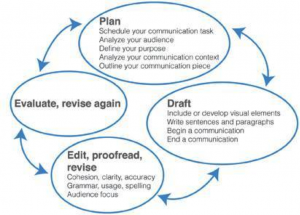To ensure your audience understands what you want to communicate, you will want to adopt a communication development process. Adhering to a defined process can make your communication tasks more efficient and effective.
What is the process for developing my communication?
The process for developing your communication typically includes these key steps that help you create your communication quickly and efficiently:

Why should I use a process for development?
Studies show engineers typically spend anywhere from 20 to 70 percent or more of their workday writing [1], but writing is only one form of communication you may engage in at work.
Whether the communication you’re developing is as simple as an email or data graph, or as complex as a report, presentation, or formal speech, following the development process will improve both your efficiency and effectiveness.
How do I use the communication development process?
Like the design processes you may be accustomed to as a professional engineer, the communication development process is iterative: you will move fluidly within it while developing your communication.
Plan
Create a plan that helps you organize your task and ideas. Planning includes numerous activities:
- Schedule your communication task
A schedule will make you conscious of your deadline, as well as the amount of time and attention you need to give to your communication task. Work backwards from the deadline and give yourself plenty of time to rethink and revise throughout the process. - Analyze your audience
Your audience is critical to the success of your communication. Knowing who they are and what they need will increase the effectiveness of your communication task. (Visit Audiencefor more details.) - Define your purpose
Your broad purpose may be to explain, persuade, analyze, or respond, for example. Ask yourself “so what?” to get to the more specific purpose of your communication task (why it’s important to your employer and audience). (Visit Purpose for more details.) - Analyze your communication context
The context of your communication includes where, how, and what you’ll be communicating. (Visit Context for more details.) - Outline your communication piece
An outline, whether formal or informal, organizes your topic and supporting ideas into a logical hierarchy. It also helps you identify your visual elements, such as tables and information graphics.
Draft
With your plan in hand, begin drafting your communication. Activities in the drafting stage include [2]:
- Write introductory paragraphs
The beginning of your communication should invite your audience in with an overview of your topic and how it’s relevant to them. - Include or develop visual elements
If your communication requires or would benefit from visual elements such as tables, charts, graphs, or figures, include them in places where they complement your content. - Write sentences and paragraphs
Your sentence and paragraph structures, as well as your choice of words contribute to the usability and persuasiveness of your communication. - Write conclusions
The end of your communication should reinforce the action you want your audience to take.
Edit, proofread, revise
Once you’ve developed a rough draft of your communication, your next step is to edit, proofread, and revise.
This stage includes editing, proofreading, and revising for
- Grammar, usage, and spelling
Do your subjects and verbs agree? Are all your sentences complete? Have you used active and passive voice appropriately? Are there any misspelled words? (Visit Improve your grammar for more information.) - Cohesion, clarity, and accuracy
Does your communication flow coherently from point to point? Have you clearly expressed the main idea? Are your supporting facts accurate? (Visit Write clearly and concisely for more information.) - Audience focus
Does your communication address the specific audience you have analyzed? Will the audience react as you want them to?
Evaluate, revise again
Once you have proofread and revised your communication, especially if the stakes are high, ask a colleague to evaluate it. He or she may catch grammar or other writing errors you missed or may have experience with the kind of audience you’re addressing. Use that feedback to revise again.
Where can I find more information about developing my communication?
- Invention and Prewriting (podcast)
This podcast from Purdue University’s Online Writing Lab (OWL) outlines strategies for the preparation, or what they call invention and prewriting, stage of the communication development process. - Preparation worksheet
This worksheet presents questions that can help you prepare for developing your communication. - Outlining guide
This guide presents the components of an effective outline.
References
[1] J.A. Leydens, “Novice and insider perspectives on academic and workplace writing: Toward a continuum of rhetorical awareness.” IEEE Transactions on Professional Communication, vol. 51, no. 3, pp. 242-263, 2008.
[2] P. V. Anderson, Technical Communication: A Reader-centered Approach. Boston: Thomson Wadsworth, 2007.

